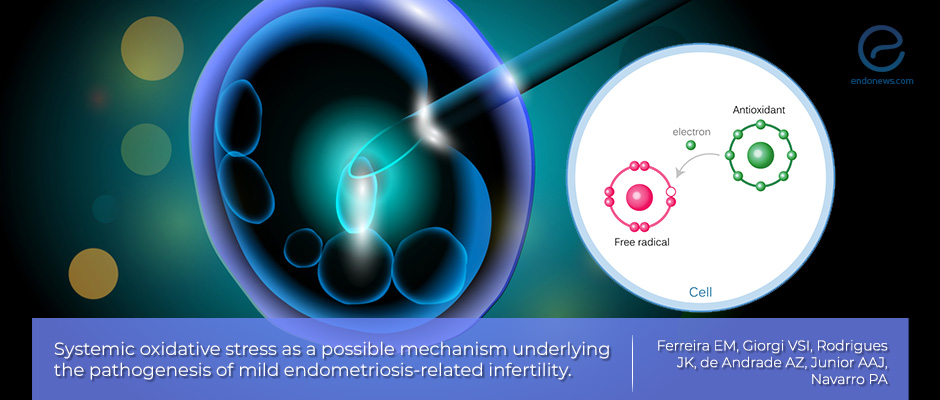Fertility and Oxidative Stress
Apr 9, 2020
Total antioxidant capacity level in blood predicts clinical pregnancy in women with mild endometriosis
Key Points
Highlight:
- This study examines whether systemic oxidative stress occurs in infertile women with endometriosis and if it can be used as a marker to predict pregnancy and live birth outcomes.
Importance:
- Oxidative stress markers in the blood may be a good predictor of clinical pregnancy and live births after intracytoplasmic sperm injection.
What has been done:
- A pilot prospective case-control study: serum samples obtained from infertile women with and without endometriosis undergoing intracytoplasmic sperm injection as part of in vitro fertilization (IVF).
- 35 women with stage I or II endometriosis and 60 control women participated.
- Oxidative stress markers: hydroperoxides, malondialdehyde, advanced oxidation protein products, reduced glutathione, superoxide dismutase, total antioxidant capacity, 8-hydroxy-2’-deoxyguanosine and vitamin E were analyzed.
- The accuracy of oxidative stress markers as clinical pregnancy and live births predictor were calculated.
Results:
- In contrary to expectation, women with stage I and II endometriosis showed lower serum 8OHdG concentrations compared with the control.
- Serum total antioxidant capacity served as the best predictor for clinical pregnancy and live birth after intracytoplasmic sperm injection in stage I or II endometriosis.
Limitation:
- This study is limited by the small sample size.
Lay Summary
One of the characteristics of endometriosis is oxidative stress caused by an imbalance between the production of reactive oxygen species and their resolution by antioxidants. Increased oxidative stress can lead to the damage of proteins, lipids, DNA and other molecules.
While current observation suggests that women with endometriosis have reduced fertility, the mechanisms for this, and the relation to oxidative stress is not clearly understood. Thus, it is difficult to develop effective pharmaceutical treatments to improve the natural fertility of women with endometriosis.
In this study by Ferreira et al., from the University of São Paulo, Brazil, the authors investigated if systemic oxidative stress in infertile women with endometriosis is associated with the outcome of intracytoplasmic sperm injection. The secondary objective was to determine the accuracy of oxidative stress markers to predict clinical pregnancy and live births. The study was published in "Reproductive BioMedicine Online".
This is a prospective, observational case-control study that recruited 35 women with stage I or II endometriosis and 60 control women between October 2009 and October 2010. All participants were in the Assisted Reproduction Program of the University Hospital. The occurrence of systemic oxidative stress was assessed from the blood sample collected from each participant during the early follicular phase of the natural cycle preceding the beginning of ovarian stimulation for intracytoplasmic sperm injection. There were eight oxidative stress markers examined, which include the concentration of hydroperoxides, reduced glutathione, vitamin E, the enzyme superoxide dismutase, and total antioxidant capacity, malondialdehyde, the products of lipid peroxidation, advanced oxidation protein products, and 8-hydroxy-2’-deoxyguanosine (8OHdG). All patients were then being followed to assess whether their assisted reproduction technology cycles were successful including live birth from women who became pregnant.
Contrary to expected results, the findings showed a lower mean of 8OHdG concentrations in the serum of infertile women with endometriosis than control women. Other markers also did not alter in women with endometriosis, suggesting that probably the systemic antioxidant defense had been mobilized.
Among the several oxidative stress markers tested, hydroperoxides showed a predictive value in determining clinical pregnancy in women without endometriosis with a sensitivity of 92.59%, a specificity of 53.85% and an accuracy of 80%. In the endometriosis group, the only marker that distinguished clinical pregnancy and live births were serum total antioxidant capacity.
Although limited by a small number of study size, this study successfully examined systemic oxidant-antioxidant balance in women with endometriosis during the early follicular phase of the menstrual cycle that has implications on the outcome of IVF. The study findings improve knowledge on the etiology of infertility in women with early-stage endometriosis, suggesting the role of oxidative stress in this process. Future studies include clinical trials investigation of whether antioxidant therapies may improve fertility and the results of assisted reproduction in infertile women with early-stage endometriosis.
Research Source: https://www.ncbi.nlm.nih.gov/pubmed/31540845/
fertility oxidative stress

